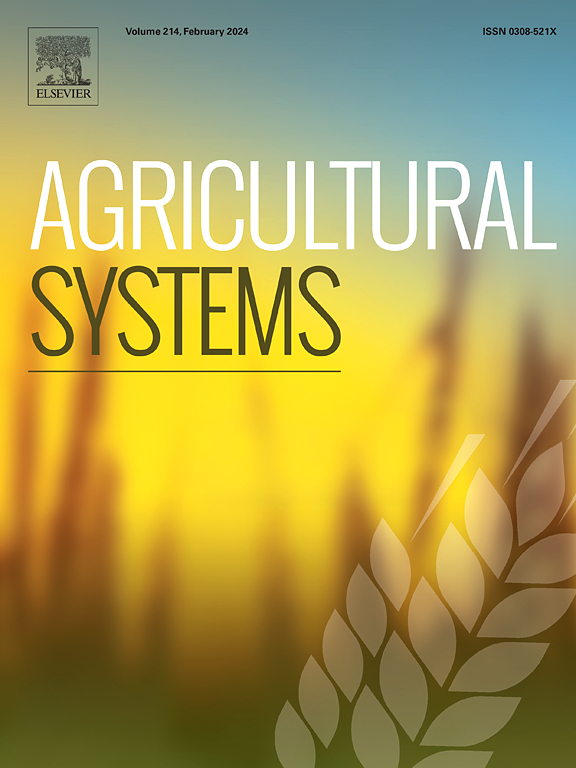探索农业4.0技术的负责任地扩大对现代农业食品生态系统的变革性影响的驱动因素:基于isms的分析
IF 6.1
1区 农林科学
Q1 AGRICULTURE, MULTIDISCIPLINARY
引用次数: 0
摘要
农业4.0的出现彻底改变了农业食品体系,引入了人工智能、物联网、无人机和数字孪生等技术,重塑了传统做法,并为应对气候变化、人口增长和资源稀缺造成的粮食危机提供了新的机遇。这些技术的采用已经引起了全球的兴趣,像“驱动程序”这样的概念已经被用来解释这种转变背后的力量。然而,关于这些驱动因素及其相互关系的研究仍然很少,这表明在理解影响农业4.0采用的因素方面存在差距。因此,本研究通过确定在现代农业食品生态系统中采用农业4.0技术的关键驱动因素来探索这一背景。此外,它还确定了这些驱动因素之间的相互关系和层次结构,为解决复杂农业食品系统的挑战和优先考虑其现代化的关键问题提供了见解。方法通过系统文献综述(SLR),确定了18个驱动因素,并将其分为3类:技术驱动因素(TD)、政治驱动因素(PD)和社会驱动因素(SD)。随后,十位专家在所有这些驱动因素之间建立了上下文关系。应用解释结构建模(ISM)方法,结合模糊矩阵影响交叉乘法分类(MICMAC)分析,识别出农业4.0驱动动力高的驱动因素和依赖驱动因素。结果与结论研究发现,影响最大的驱动因素——农村连通性、农村青年、政府压力、信息披露机制和生态系统代表性——在塑造农业4.0技术的采用动态方面拥有最大的驱动力。这些因素是核心杠杆,不仅直接影响采用,而且还放大了农业食品系统中其他驱动因素的影响。如果忽视这些主要驱动因素,它们可能会产生结构性和社会瓶颈,阻碍甚至阻碍农业4.0的有效整合,特别是在小农村和资源有限的情况下。从战略角度看,加强农村互联互通和促进农村青年积极参与是加强长期收养能力的基础性行动。与此同时,决策者应加强治理框架,确保透明度,促进可靠信息的自由流动,并将生态系统多样性和代表性纳入农业创新政策。通过解决这些相互关联的驱动因素,并与各自集群中的其他促进驱动因素协同作用,就有可能在发展中地区和发达地区加速向更公平、更高效和更可持续的农业粮食生态系统过渡。本研究结果有助于在不同地区和国家更有意义地采用农业4.0技术,为更公平、更公平地实施农业4.0铺平道路,同时支持发展更具生产力、抵御力和可持续的农业粮食系统。虽然证据来自巴西的情况,但其见解和建议也适用于寻求实现农业粮食生态系统现代化的其他地区。本文章由计算机程序翻译,如有差异,请以英文原文为准。

Exploring the drivers of responsible scaling of Agriculture 4.0 technologies for transformative impact in the modern agri-food ecosystem: An ISM-based analysis
CONTEXT
The emergence of Agriculture 4.0 has revolutionized the agri-food system, introducing technologies like AI, IoT, drones, and digital twins that reshape traditional practices and offer new opportunities to address food crises driven by climate change, population growth, and resource scarcity. The adoption of these technologies has gained global interest, and concepts like “drivers” have been used to explain the forces behind this transformation. However, studies on these drivers and their interrelationships remain scarce, highlighting a gap in understanding the factors influencing the adoption of Agriculture 4.0.
OBJECTIVE
This research, therefore, explores this context by identifying the key drivers for the adoption of Agriculture 4.0 technologies in the modern agri-food ecosystem. Additionally, it identifies the interrelationships and hierarchical structures among these drivers, providing insights to tackle the challenges of complex agri-food systems and prioritize key issues for their modernization.
METHODS
A total of eighteen drivers were identified through a Systematic Literature Review (SLR) and classified into three clusters: Technological Drivers (TD), Political Drivers (PD), and Social Drivers (SD). Subsequently, ten experts established contextual relationships among all these drivers. The Interpretive Structural Modeling (ISM) method was applied, along with the fuzzy Matrix Impact of Cross Multiplication Applied to Classification (MICMAC) analysis, which enabled the identification of Agriculture 4.0 drivers with high driving power and those that are dependent.
RESULTS AND CONCLUSIONS
The study's findings reveal that the most influential drivers — rural connectivity, rural youth, governmental pressure, information disclosure mechanisms, and ecosystem representativeness — hold the greatest driving power in shaping the adoption dynamics of Agriculture 4.0 technologies. These elements act as core levers that not only directly influence adoption but also amplify the effect of other drivers within the agri-food system. When these primary drivers are overlooked, they can generate structural and social bottlenecks that hinder — or even block — the effective integration of Agriculture 4.0, especially in small rural and resource-limited contexts. From a strategic perspective, enhancing rural connectivity and fostering the active participation of rural youth emerge as foundational actions to strengthen long-term adoption capacity. In parallel, policymakers should reinforce governance frameworks that ensure transparency, facilitate the free flow of reliable information, and integrate ecosystem diversity and representativeness into agricultural innovation policies. By addressing these interconnected drivers in synergy with other enabling drivers across their respective clusters, it becomes possible to accelerate the transition toward more equitable, productive, and sustainable agri-food ecosystems in both developing and developed regions.
SIGNIFICANCE
This research's results contribute to a more meaningful adoption of Agriculture 4.0 technologies across different regions and countries, paving the way for a fairer and more equitable implementation while supporting the development of more productive, resilient, and sustainable agri-food systems. Although the evidence is drawn from the Brazilian context, the insights and recommendations are also relevant for other regions seeking to modernize their agri-food ecosystems.
求助全文
通过发布文献求助,成功后即可免费获取论文全文。
去求助
来源期刊

Agricultural Systems
农林科学-农业综合
CiteScore
13.30
自引率
7.60%
发文量
174
审稿时长
30 days
期刊介绍:
Agricultural Systems is an international journal that deals with interactions - among the components of agricultural systems, among hierarchical levels of agricultural systems, between agricultural and other land use systems, and between agricultural systems and their natural, social and economic environments.
The scope includes the development and application of systems analysis methodologies in the following areas:
Systems approaches in the sustainable intensification of agriculture; pathways for sustainable intensification; crop-livestock integration; farm-level resource allocation; quantification of benefits and trade-offs at farm to landscape levels; integrative, participatory and dynamic modelling approaches for qualitative and quantitative assessments of agricultural systems and decision making;
The interactions between agricultural and non-agricultural landscapes; the multiple services of agricultural systems; food security and the environment;
Global change and adaptation science; transformational adaptations as driven by changes in climate, policy, values and attitudes influencing the design of farming systems;
Development and application of farming systems design tools and methods for impact, scenario and case study analysis; managing the complexities of dynamic agricultural systems; innovation systems and multi stakeholder arrangements that support or promote change and (or) inform policy decisions.
 求助内容:
求助内容: 应助结果提醒方式:
应助结果提醒方式:


